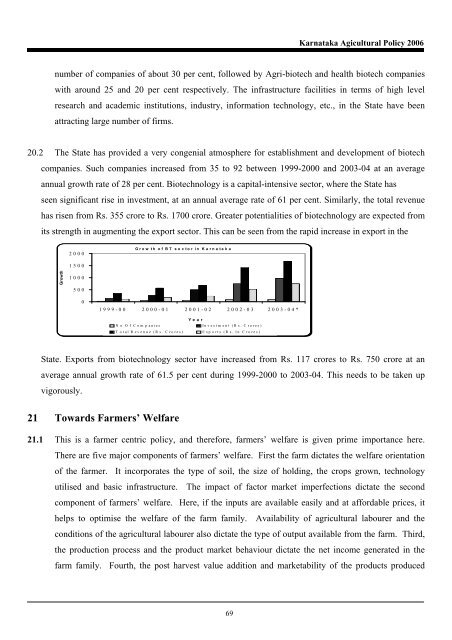Karnataka Agricultural Policy - Institute for Social and Economic ...
Karnataka Agricultural Policy - Institute for Social and Economic ...
Karnataka Agricultural Policy - Institute for Social and Economic ...
Create successful ePaper yourself
Turn your PDF publications into a flip-book with our unique Google optimized e-Paper software.
<strong>Karnataka</strong> Agicultural <strong>Policy</strong> 2006<br />
number of companies of about 30 per cent, followed by Agri-biotech <strong>and</strong> health biotech companies<br />
with around 25 <strong>and</strong> 20 per cent respectively. The infrastructure facilities in terms of high level<br />
research <strong>and</strong> academic institutions, industry, in<strong>for</strong>mation technology, etc., in the State have been<br />
attracting large number of firms.<br />
20.2 The State has provided a very congenial atmosphere <strong>for</strong> establishment <strong>and</strong> development of biotech<br />
companies. Such companies increased from 35 to 92 between 1999-2000 <strong>and</strong> 2003-04 at an average<br />
annual growth rate of 28 per cent. Biotechnology is a capital-intensive sector, where the State has<br />
seen significant rise in investment, at an annual average rate of 61 per cent. Similarly, the total revenue<br />
has risen from Rs. 355 crore to Rs. 1700 crore. Greater potentialities of biotechnology are expected from<br />
its strength in augmenting the export sector. This can be seen from the rapid increase in export in the<br />
2000<br />
G r o w th o f B T s e c to r in K a r n a ta k a<br />
1500<br />
Growth<br />
1000<br />
500<br />
0<br />
1999-00 2000-01 2001-02 2002-03 2003-04*<br />
N o O f C o m p an ies<br />
T otal Revenue (Rs. Crores)<br />
Year<br />
Investm ent (Rs. Crores)<br />
Exp orts (R s. In C rores)<br />
State. Exports from biotechnology sector have increased from Rs. 117 crores to Rs. 750 crore at an<br />
average annual growth rate of 61.5 per cent during 1999-2000 to 2003-04. This needs to be taken up<br />
vigorously.<br />
21 Towards Farmers’ Welfare<br />
21.1 This is a farmer centric policy, <strong>and</strong> there<strong>for</strong>e, farmers’ welfare is given prime importance here.<br />
There are five major components of farmers’ welfare. First the farm dictates the welfare orientation<br />
of the farmer. It incorporates the type of soil, the size of holding, the crops grown, technology<br />
utilised <strong>and</strong> basic infrastructure. The impact of factor market imperfections dictate the second<br />
component of farmers’ welfare. Here, if the inputs are available easily <strong>and</strong> at af<strong>for</strong>dable prices, it<br />
helps to optimise the welfare of the farm family. Availability of agricultural labourer <strong>and</strong> the<br />
conditions of the agricultural labourer also dictate the type of output available from the farm. Third,<br />
the production process <strong>and</strong> the product market behaviour dictate the net income generated in the<br />
farm family. Fourth, the post harvest value addition <strong>and</strong> marketability of the products produced<br />
69

















